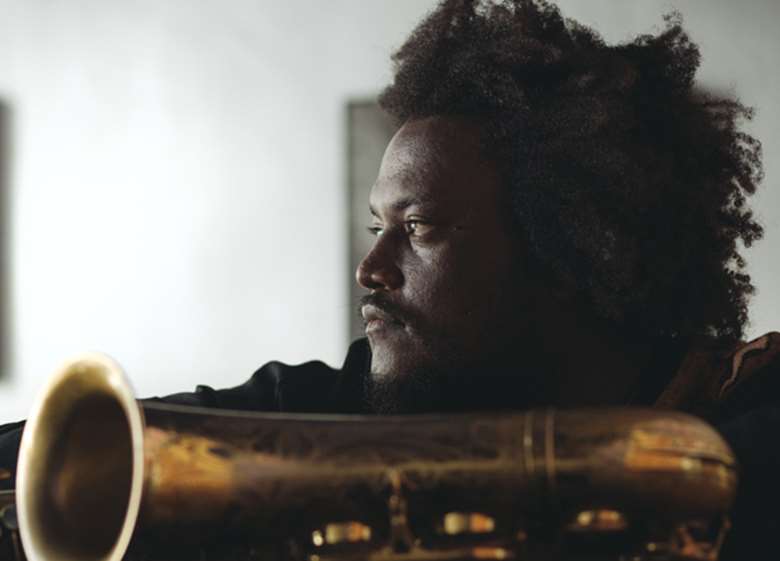Kamasi Washington – Big Bang Theory
Wednesday, November 4, 2015
There are few, if any, jazz triple albums that have made quite the impact that Kamasi Washington’s The Epic has had this year.

Kevin Le Gendre spoke to the Los Angeles-based saxophonist about how his seismic spiritually-charged music came from his formative years playing in church and a deep well of like-minded forebears
Historically, the west coast of America may be synonymous with jazz that is ‘cool’, but many of its players also went straight ‘into the hot’. Certainly, the likes of Dexter Gordon knew how to burn and today there is a Los Angeles jazz scene that is ablaze with ideas as well as intense performances, producing artists such as 34-year-old saxophonist Kamasi Washington. His The Epic is arguably debut album of the year, a work whose earthy maturity is matched only by its fiery ambition.
At its core is a crack 10-piece band featuring electric bassist Thundercat, but it is the inclusion of a 32-piece string orchestra and 20-strong choir that makes the 172 minutes of the triple CD a digital age rhapsody. Unsurprisingly, its roots run deep. Washington’s mentor is none other than the big band legend Gerald Wilson. In 2006 the younger artist/musician had a very significant meeting with the veteran composer.
“I was showing Gerald a live recording of my band The Next Step and Brandon Coleman was playing some keyboard strings,” Washington told me in a recent email exchange. “Gerald and I had talked about classical music and orchestration a lot over the years and he really liked the sound of what Brandon was doing, and told me I should write some orchestral pieces that would include that band.”
Son of respected Angeleno saxophonist Ricky Washington, Kamasi, who majored in Ethnomusicology at UCLA and counts Jeff Clayton among his other essential tutors, was subsequently asked to make a record by Flying Lotus, the interstellar producer whose A&R policy at the fiercely progressive Brainfeeder label brought to light the aforementioned Thundercat. Significantly, Lotus gave Washington creative carte blanche. “That sense of freedom led me back to the memory of that day with Gerald,” Washington says. “It was my opportunity to do some things on that scale. I didn’t want to lock the musicians into a rigid arrangement of orchestrations. The magic of what we do comes from having the freedom to move the music the way the moment asks us.”
So Washington opted to record his bandmembers first to enable them to “do what they hear”, before arranging the strings and voices around “what we did spontaneously, so I could get the best of both worlds”.
The result was a series of sweeping, soul-stirring anthems that lean equally to jazz, gospel and classical traditions, and it was indeed an iconic composer from the last canon that acted as a key pathfinder. “My biggest inspiration on the choral side actually came from Stravinsky’s ‘Symphony of Psalms’,” Washington reveals. “I used to listen to that and dream of improvising over it with a live orchestra and chorus. But there are others as well, like the Charlie Parker With Strings album, Marvin Gaye’s What’s Going On, Norman Connors’ Dark Of Light and Donald Byrd’s Cristo Redentor. I listen to a lot of music!” Bigger is better on The Epic. Washington has a lot of musicians in his orbit and rather than diminish numbers he decided to augment when circumstances conspired to fill the rehearsal room to bursting. “My big band The Next Step came together in a way by chance. I’ve known everyone in my band since I was a kid, some as early as three years old. We’ve always played with each other and been in each other’s bands but we’d never had everyone on the same gig at the same time,” says Washington. “One night I had a gig at a club called 5th Street Dicks and Cameron Graves, Thundercat and Ronald Bruner were supposed to be the rhythm section. I forget the reason they all ended up cancelling on me the day of the gig, so I called Miles Mosley, Brandon Coleman and Tony Austin to come play and somehow they all showed up! My first thought was to have them do alternate sets, then I thought it would be interesting to see how they would all sound together. We sounded amazing, you would think we had been playing with a double rhythm section for years the way everything fit so perfectly.”
Musical osmosis aside, the emotional charge of The Epic can be traced to an experience Washington had as a boy that proved a turning point in his life as a musician. At the age of 13 he used his father’s horn without permission to figure out how to play his favorite song at the time – Wayne Shorter’s ‘Sleeping Dancer Sleep On’. “I ran and showed him and he immediately took me seriously. Literally, the next day he took me to join the band at my uncle’s church! At my uncle’s church they were so into the spirit of music. We never knew how we were going to play the songs or even what key they were going to be in, everything had to be, as the choir director would say, ‘led by the spirit’. All the musicians and singers would just flow and at some point every week we would reach these amazing climaxes! As I learned about other musical traditions, styles, and cultures I’ve always found that so much of the music that I really loved had that same kind of approach even if the musicians didn’t mean to make ‘spiritual music’.”
Discover...
Review Kamasi Washington – The Epic ★★★★ Recommended
Feature Sons of Kemet – Rhythms of Remembrance
Feature Branford Marsalis – Spiritual Soliloquy
This article originally appeared in the August 2015 issue of Jazzwise. Subscribe to Jazzwise